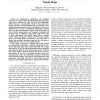Free Online Productivity Tools
i2Speak
i2Symbol
i2OCR
iTex2Img
iWeb2Print
iWeb2Shot
i2Type
iPdf2Split
iPdf2Merge
i2Bopomofo
i2Arabic
i2Style
i2Image
i2PDF
iLatex2Rtf
Sci2ools
ICRA
2009
IEEE
2009
IEEE
Automatically and efficiently inferring the hierarchical structure of visual maps
In Simultaneous Localisation and Mapping (SLAM), it is well known that probabilistic filtering approaches which aim to estimate the robot and map state sequentially suffer from poor computational scaling to large map sizes. Various authors have demonstrated that this problem can be mitigated by approximations which treat estimates of features in different parts of a map as conditionally independent, allowing them to be processed separately. When it comes to the choice of how to divide a large map into such `submaps', straightforward heuristics may be sufficient in maps built using sensors such as laser range-finders with limited range, where a regular grid of submap boundaries performs well. With visual sensing, however, the ideal division of submaps is less clear, since a camera has potentially unlimited range and will often observe spatially distant parts of a scene simultaneously. In this paper we present an efficient and generic method for automatically determining a suitable ...
| Added | 19 Feb 2011 |
| Updated | 19 Feb 2011 |
| Type | Journal |
| Year | 2009 |
| Where | ICRA |
| Authors | Margarita Chli, Andrew J. Davison |
Comments (0)

